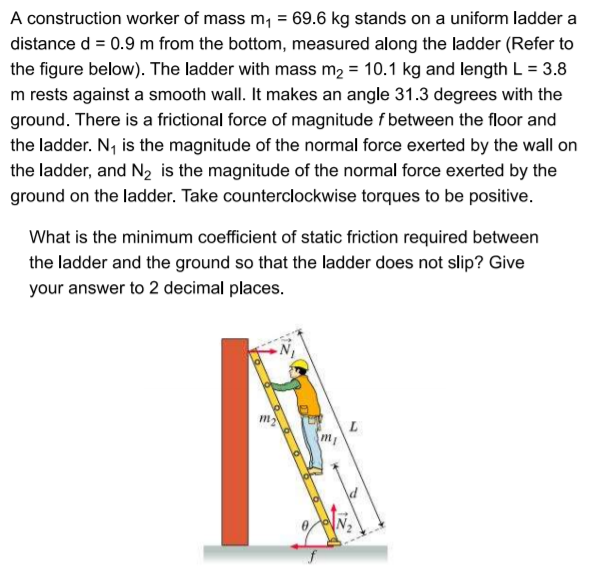A construction worker of mass m, = 69.6 kg stands on a uniform ladder a distance d = 0.9 m from the bottom, measured along the ladder (Refer to the figure below). The ladder with mass m2 = 10.1 kg and length L = 3.8 m rests against a smooth wall. It makes an angle 31.3 degrees with the ground. There is a frictional force of magnitude f between the floor and the ladder. N, is the magnitude of the normal force exerted by the wall on the ladder, and N2 is the magnitude of the normal force exerted by the
A construction worker of mass m, = 69.6 kg stands on a uniform ladder a distance d = 0.9 m from the bottom, measured along the ladder (Refer to the figure below). The ladder with mass m2 = 10.1 kg and length L = 3.8 m rests against a smooth wall. It makes an angle 31.3 degrees with the ground. There is a frictional force of magnitude f between the floor and the ladder. N, is the magnitude of the normal force exerted by the wall on the ladder, and N2 is the magnitude of the normal force exerted by the
Principles of Physics: A Calculus-Based Text
5th Edition
ISBN:9781133104261
Author:Raymond A. Serway, John W. Jewett
Publisher:Raymond A. Serway, John W. Jewett
Chapter10: Rotational Motion
Section: Chapter Questions
Problem 28P: A uniform beam resting on two pivots has a length L = 6.00 m and mass M = 90.0 kg. The pivot under...
Related questions
Concept explainers
Rotational Equilibrium And Rotational Dynamics
In physics, the state of balance between the forces and the dynamics of motion is called the equilibrium state. The balance between various forces acting on a system in a rotational motion is called rotational equilibrium or rotational dynamics.
Equilibrium of Forces
The tension created on one body during push or pull is known as force.
Question

Transcribed Image Text:A construction worker of mass m, = 69.6 kg stands on a uniform ladder a
distance d = 0.9 m from the bottom, measured along the ladder (Refer to
the figure below). The ladder with mass m2 = 10.1 kg and length L = 3.8
m rests against a smooth wall. It makes an angle 31.3 degrees with the
ground. There is a frictional force of magnitude f between the floor and
the ladder. N, is the magnitude of the normal force exerted by the wall on
the ladder, and N2 is the magnitude of the normal force exerted by the
ground on the ladder. Take counterclockwise torques to be positive.
What is the minimum coefficient of static friction required between
the ladder and the ground so that the ladder does not slip? Give
your answer to 2 decimal places.
m
Expert Solution
This question has been solved!
Explore an expertly crafted, step-by-step solution for a thorough understanding of key concepts.
Step by step
Solved in 2 steps with 1 images

Knowledge Booster
Learn more about
Need a deep-dive on the concept behind this application? Look no further. Learn more about this topic, physics and related others by exploring similar questions and additional content below.Recommended textbooks for you

Principles of Physics: A Calculus-Based Text
Physics
ISBN:
9781133104261
Author:
Raymond A. Serway, John W. Jewett
Publisher:
Cengage Learning

Principles of Physics: A Calculus-Based Text
Physics
ISBN:
9781133104261
Author:
Raymond A. Serway, John W. Jewett
Publisher:
Cengage Learning